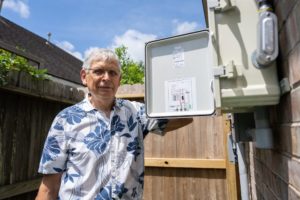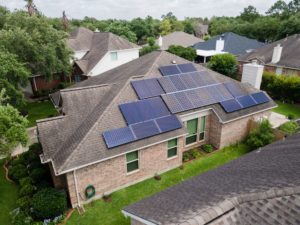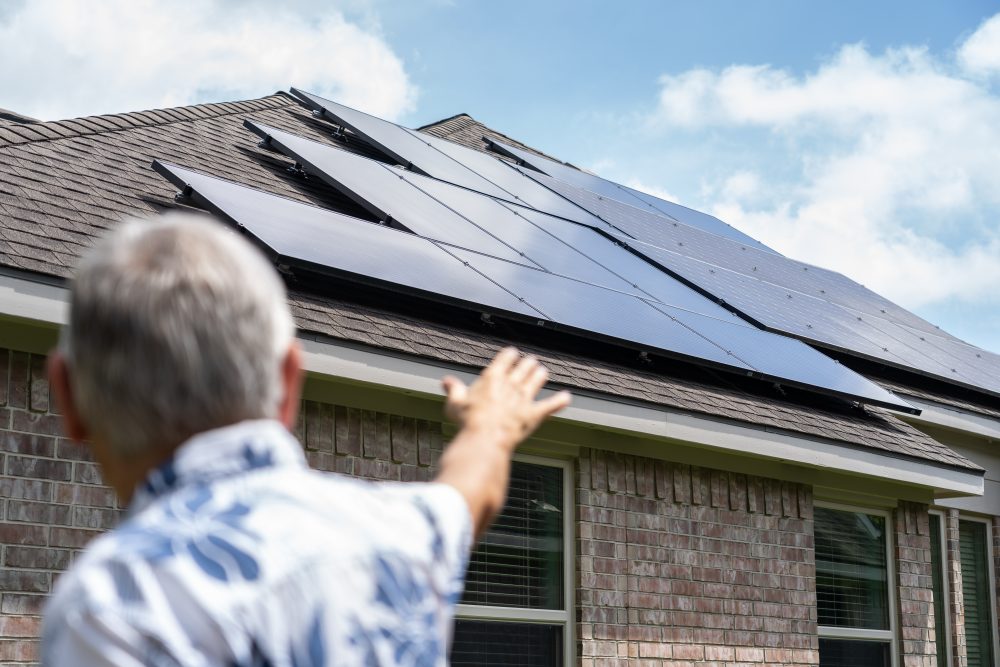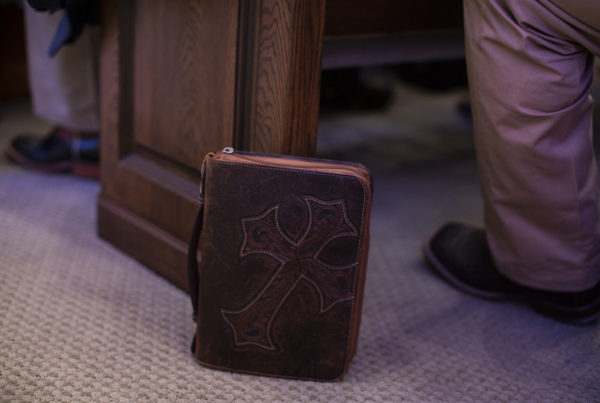On a muggy Monday morning, the sun beats down on Wally Calaway’s house in Clear Lake. Seen from the front, his home doesn’t look much different than any of the other houses on the block.
But walking around the south side of his home, the roof suddenly begins to shimmer with more than two dozen solar panels reflecting light from the sun.
Calaway, a retired scientist, said he thought about going solar for years before joining a solar cooperative in 2016. For him, climate change was the driving factor.
“I’m concerned about the environment,” he said. “I can hardly force the Texas grid to go any faster than it’s going to solar, renewable energy, but I can change my household.”

Calaway stands next to the control panel for his solar panels.
Lucio Vasquez / Houston Public Media
Calaway and his wife initially installed 11 solar panels. This March, they added 14 more.
Though cutting back on fossil fuels is what drew him to solar, Calaway said there are economic benefits too — especially since their extra panels were added.
“I haven’t paid a bill. I’ve just been collecting a credit since they were turned on,” he said.
Calaway is one of a growing number of Houstonians who have chosen to go solar. In the past several years, installed solar power has more than quadrupled with no signs of slowing down.
Installed solar capacity in Houston grew from about 9.5 megawatts at the end of 2017 to 42.53 megawatts at the end of 2019 — enough to power about 8,400 homes, according to Environment Texas, which has been tracking solar growth in Texas cities for nearly a decade.
“For the first several years, growth of solar and Houston was pretty slow, but in the last several years, it’s really skyrocketed,” said Luke Metzger, the executive director of Environment Texas.
Even during 2020, in the midst of the pandemic, Houston’s permitting office says it saw the number of solar permits more than double compared to the year before.
Increasing solar power from local rooftops and community projects is one of the goals of the city’s Climate Action Plan, which outlines a series of recommendations for Houston to become carbon neutral by 2050. Specifically, the city aims to generate 5 million megawatt-hours from local solar projects per year by 2050.
To help meet that goal, Mayor Sylvester Turner recently announced the launch of a citywide solar cooperative to make it easier for residents and businesses to install panels on their roofs. A project to turn a former landfill in Sunnyside into a solar farm is also underway. When completed it will have a 70-megawatt solar array with the capacity to generate enough electricity to power 12,000 homes.
But Houston still lags behind other Texas cities like San Antonio and Austin in terms of total installed solar capacity.
“Just comparing Houston to other cities around the country, it ranks pretty poorly in terms of total solar, given the size of its population,” Metzger said. “So while there’s been significant growth in the last few years, Houston still has a long way to go.”
Metzger said one reason that solar took off more quickly in cities like Austin and San Antonio is that utilities there offer rebates for going solar — something Centerpoint Energy has not done.
But that’s become less of a factor in recent years as prices have gone down on their own.
“Even without the rebates, with the federal tax credit and the significant decline in the cost of solar, the economics make sense for far more people now,” Metzger said.
The federal tax credit is currently set to expire in 2022, though under President Biden’s proposed infrastructure plan it could be extended for another decade.

Solar panels on a rooftop in Clear Lake. Installed solar capacity in Houston has quadrupled in recent years, as more homeowners are installing panels on their roofs.
Lucio Vasquez / Houston Public Media
Another factor that has helped make it easier for some homeowners to switch to solar is an increasing number of solar co-ops. Calaway, the Clear Lake homeowner, joined solar co-ops both times he installed panels on his home.
“It was only natural to join a co-op because it was such an easy process to get our solar panels,” he said.
The co-op model works by bringing together a group of people in a similar area who all want to go solar at the same time. That helps bring down the cost and streamline the process.
“We try to take away the barriers of going solar,” said Dori Wolfe, the Houston-area co-op coordinator with the nonprofit Solar United Neighbors. SUN has launched six co-ops in the Houston area in the past three years, including the recent citywide co-op that was launched in conjunction with the city in April.
Wolfe said SUN helps with some of the more technical parts of the process, such as permitting, determining if your home is even right for solar and choosing a retail electricity provider with a buyback program.
Over the 25-year lifetime of the panels, SUN estimates homeowners can save up to $23,000.
“What we say is, most solar homeowners see a return on their investment of between 10 and 15 years, somewhere within that range they can pay off their array through savings,” Wolfe said.
Since the citywide co-op launched in April, Wolfe said interest has skyrocketed, in part because of the winter freeze. More than 200 people have joined the citywide co-op so far.
“That’s just huge,” Wolfe said. “During the pandemic, we would work to get up to 40 people.”














